Legal Analysis: Jenny's Injury and Hunter Busline's Exclusion Clause
VerifiedAdded on 2023/06/05
|7
|1359
|229
Case Study
AI Summary
This case study analyzes the legal implications of an injury sustained by Jenny on a Hunter Busline bus, focusing on the validity and applicability of an exclusion clause. The core issue revolves around whether Jenny can sue Hunter Busline for damages despite the presence of an exclusion clause stating the bus line is not liable for passenger injuries. The analysis applies principles of contract law, particularly concerning offer, acceptance, consideration, and the timing of the exclusion clause's incorporation into the contract. Referencing precedent cases such as Thornton v Shoe Lane Parking and Thompson v London, Midland and Scotland Railway Co, the study concludes that Jenny can indeed sue Hunter Busline because the exclusion clause was presented after the contract (ticket purchase) was already in effect, rendering it invalid, despite Jenny's negligence in removing her seatbelt.
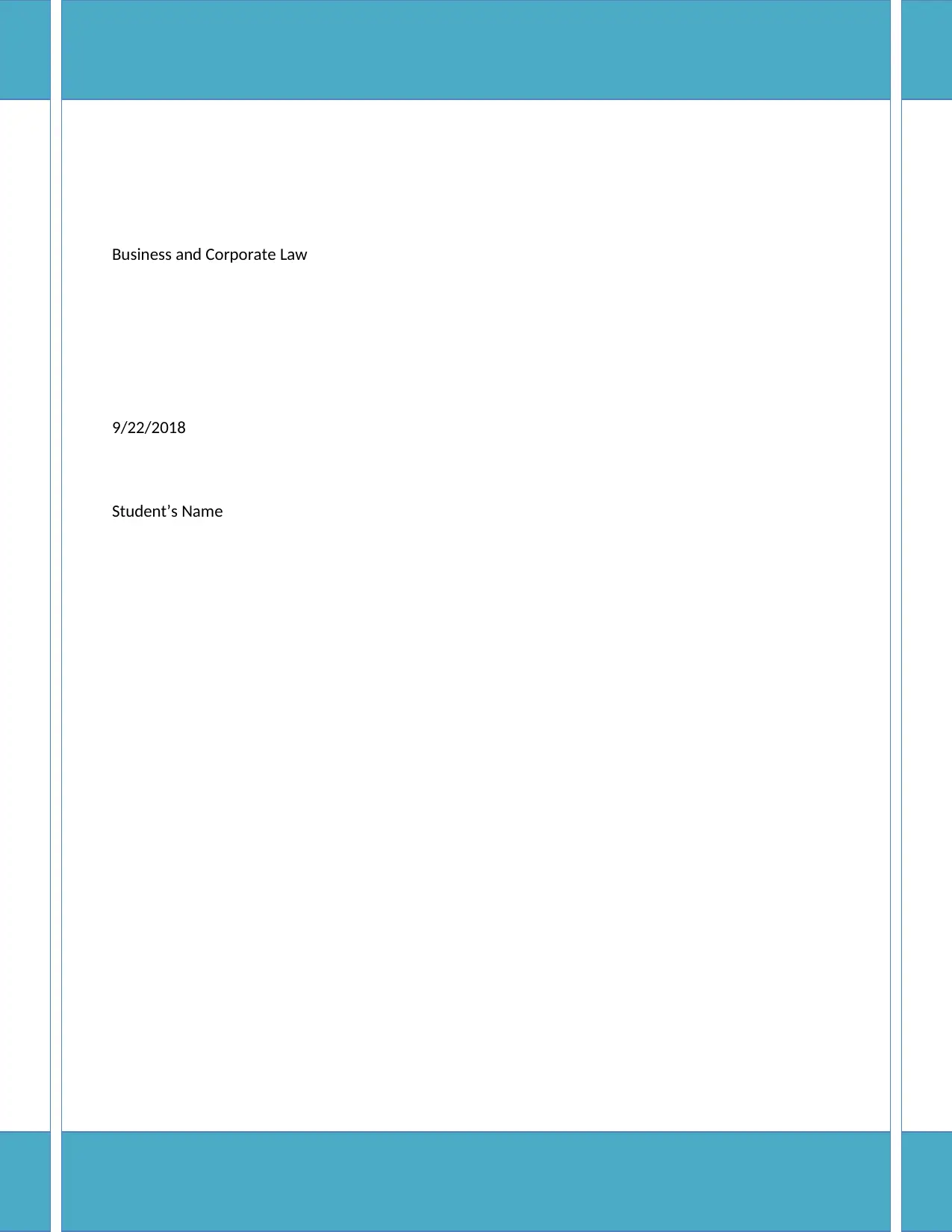
Running Head: BUSINESS AND CORPORATION LAW 0
Business and Corporate Law
9/22/2018
Student’s Name
Business and Corporate Law
9/22/2018
Student’s Name
Paraphrase This Document
Need a fresh take? Get an instant paraphrase of this document with our AI Paraphraser
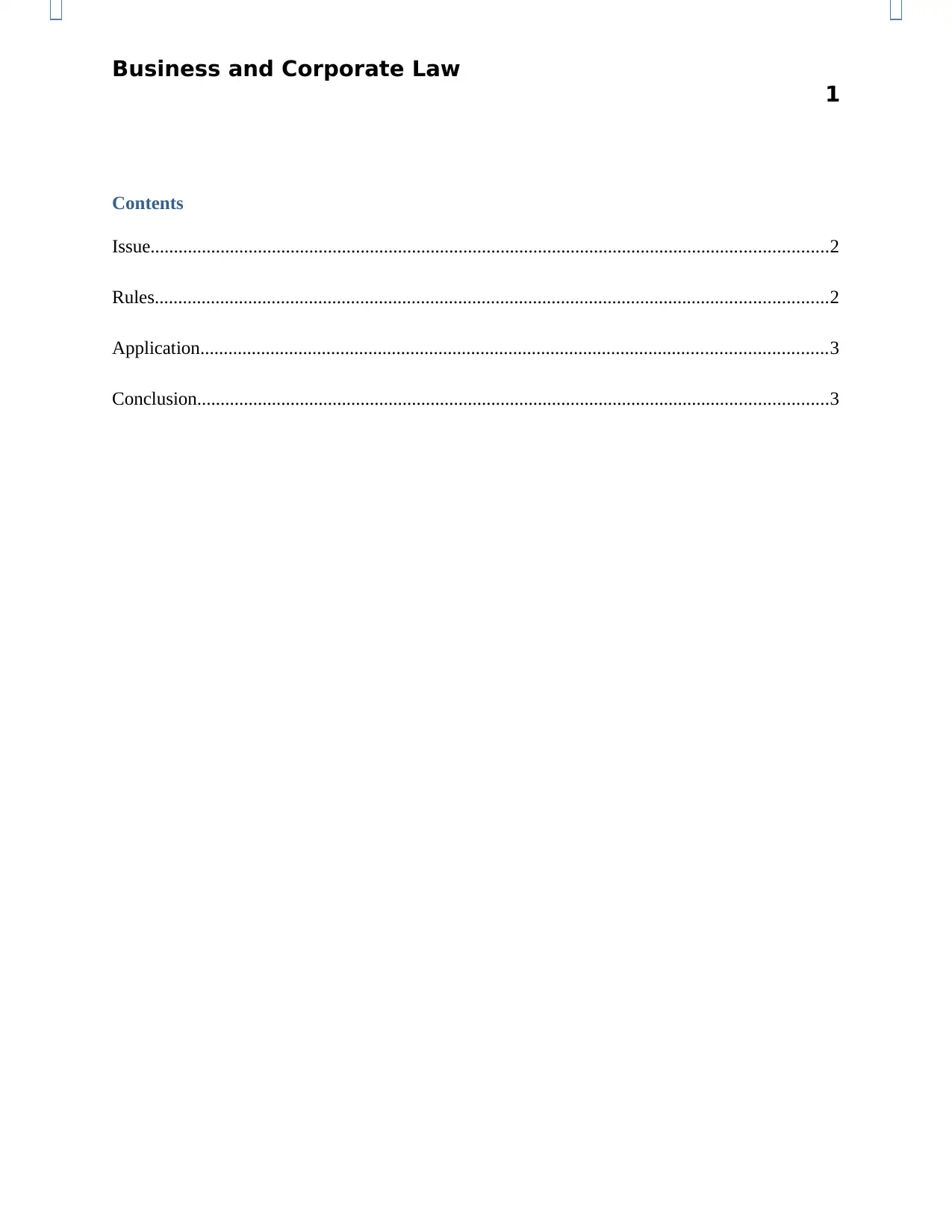
Business and Corporate Law
1
Contents
Issue.................................................................................................................................................2
Rules................................................................................................................................................2
Application......................................................................................................................................3
Conclusion.......................................................................................................................................3
1
Contents
Issue.................................................................................................................................................2
Rules................................................................................................................................................2
Application......................................................................................................................................3
Conclusion.......................................................................................................................................3
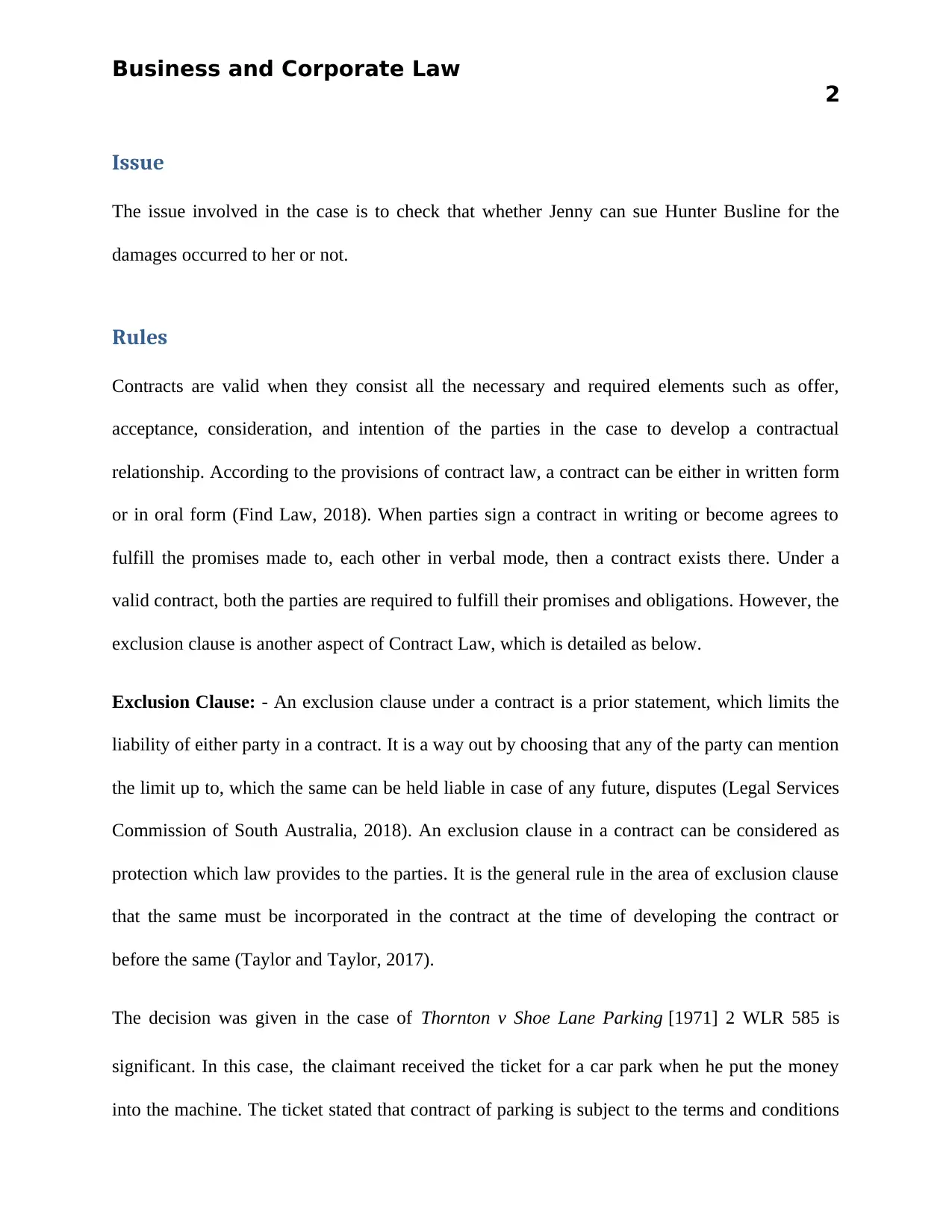
Business and Corporate Law
2
Issue
The issue involved in the case is to check that whether Jenny can sue Hunter Busline for the
damages occurred to her or not.
Rules
Contracts are valid when they consist all the necessary and required elements such as offer,
acceptance, consideration, and intention of the parties in the case to develop a contractual
relationship. According to the provisions of contract law, a contract can be either in written form
or in oral form (Find Law, 2018). When parties sign a contract in writing or become agrees to
fulfill the promises made to, each other in verbal mode, then a contract exists there. Under a
valid contract, both the parties are required to fulfill their promises and obligations. However, the
exclusion clause is another aspect of Contract Law, which is detailed as below.
Exclusion Clause: - An exclusion clause under a contract is a prior statement, which limits the
liability of either party in a contract. It is a way out by choosing that any of the party can mention
the limit up to, which the same can be held liable in case of any future, disputes (Legal Services
Commission of South Australia, 2018). An exclusion clause in a contract can be considered as
protection which law provides to the parties. It is the general rule in the area of exclusion clause
that the same must be incorporated in the contract at the time of developing the contract or
before the same (Taylor and Taylor, 2017).
The decision was given in the case of Thornton v Shoe Lane Parking [1971] 2 WLR 585 is
significant. In this case, the claimant received the ticket for a car park when he put the money
into the machine. The ticket stated that contract of parking is subject to the terms and conditions
2
Issue
The issue involved in the case is to check that whether Jenny can sue Hunter Busline for the
damages occurred to her or not.
Rules
Contracts are valid when they consist all the necessary and required elements such as offer,
acceptance, consideration, and intention of the parties in the case to develop a contractual
relationship. According to the provisions of contract law, a contract can be either in written form
or in oral form (Find Law, 2018). When parties sign a contract in writing or become agrees to
fulfill the promises made to, each other in verbal mode, then a contract exists there. Under a
valid contract, both the parties are required to fulfill their promises and obligations. However, the
exclusion clause is another aspect of Contract Law, which is detailed as below.
Exclusion Clause: - An exclusion clause under a contract is a prior statement, which limits the
liability of either party in a contract. It is a way out by choosing that any of the party can mention
the limit up to, which the same can be held liable in case of any future, disputes (Legal Services
Commission of South Australia, 2018). An exclusion clause in a contract can be considered as
protection which law provides to the parties. It is the general rule in the area of exclusion clause
that the same must be incorporated in the contract at the time of developing the contract or
before the same (Taylor and Taylor, 2017).
The decision was given in the case of Thornton v Shoe Lane Parking [1971] 2 WLR 585 is
significant. In this case, the claimant received the ticket for a car park when he put the money
into the machine. The ticket stated that contract of parking is subject to the terms and conditions
⊘ This is a preview!⊘
Do you want full access?
Subscribe today to unlock all pages.

Trusted by 1+ million students worldwide
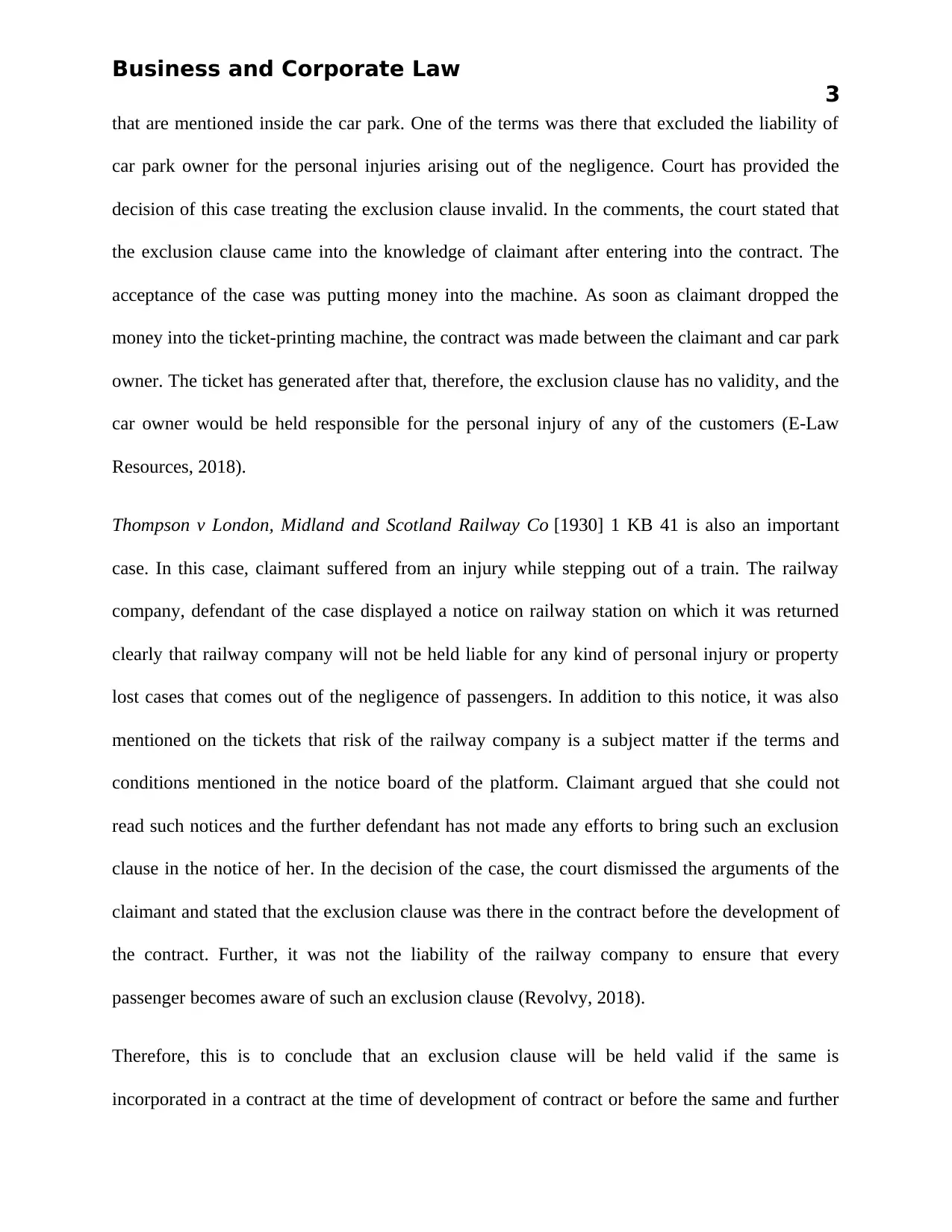
Business and Corporate Law
3
that are mentioned inside the car park. One of the terms was there that excluded the liability of
car park owner for the personal injuries arising out of the negligence. Court has provided the
decision of this case treating the exclusion clause invalid. In the comments, the court stated that
the exclusion clause came into the knowledge of claimant after entering into the contract. The
acceptance of the case was putting money into the machine. As soon as claimant dropped the
money into the ticket-printing machine, the contract was made between the claimant and car park
owner. The ticket has generated after that, therefore, the exclusion clause has no validity, and the
car owner would be held responsible for the personal injury of any of the customers (E-Law
Resources, 2018).
Thompson v London, Midland and Scotland Railway Co [1930] 1 KB 41 is also an important
case. In this case, claimant suffered from an injury while stepping out of a train. The railway
company, defendant of the case displayed a notice on railway station on which it was returned
clearly that railway company will not be held liable for any kind of personal injury or property
lost cases that comes out of the negligence of passengers. In addition to this notice, it was also
mentioned on the tickets that risk of the railway company is a subject matter if the terms and
conditions mentioned in the notice board of the platform. Claimant argued that she could not
read such notices and the further defendant has not made any efforts to bring such an exclusion
clause in the notice of her. In the decision of the case, the court dismissed the arguments of the
claimant and stated that the exclusion clause was there in the contract before the development of
the contract. Further, it was not the liability of the railway company to ensure that every
passenger becomes aware of such an exclusion clause (Revolvy, 2018).
Therefore, this is to conclude that an exclusion clause will be held valid if the same is
incorporated in a contract at the time of development of contract or before the same and further
3
that are mentioned inside the car park. One of the terms was there that excluded the liability of
car park owner for the personal injuries arising out of the negligence. Court has provided the
decision of this case treating the exclusion clause invalid. In the comments, the court stated that
the exclusion clause came into the knowledge of claimant after entering into the contract. The
acceptance of the case was putting money into the machine. As soon as claimant dropped the
money into the ticket-printing machine, the contract was made between the claimant and car park
owner. The ticket has generated after that, therefore, the exclusion clause has no validity, and the
car owner would be held responsible for the personal injury of any of the customers (E-Law
Resources, 2018).
Thompson v London, Midland and Scotland Railway Co [1930] 1 KB 41 is also an important
case. In this case, claimant suffered from an injury while stepping out of a train. The railway
company, defendant of the case displayed a notice on railway station on which it was returned
clearly that railway company will not be held liable for any kind of personal injury or property
lost cases that comes out of the negligence of passengers. In addition to this notice, it was also
mentioned on the tickets that risk of the railway company is a subject matter if the terms and
conditions mentioned in the notice board of the platform. Claimant argued that she could not
read such notices and the further defendant has not made any efforts to bring such an exclusion
clause in the notice of her. In the decision of the case, the court dismissed the arguments of the
claimant and stated that the exclusion clause was there in the contract before the development of
the contract. Further, it was not the liability of the railway company to ensure that every
passenger becomes aware of such an exclusion clause (Revolvy, 2018).
Therefore, this is to conclude that an exclusion clause will be held valid if the same is
incorporated in a contract at the time of development of contract or before the same and further
Paraphrase This Document
Need a fresh take? Get an instant paraphrase of this document with our AI Paraphraser
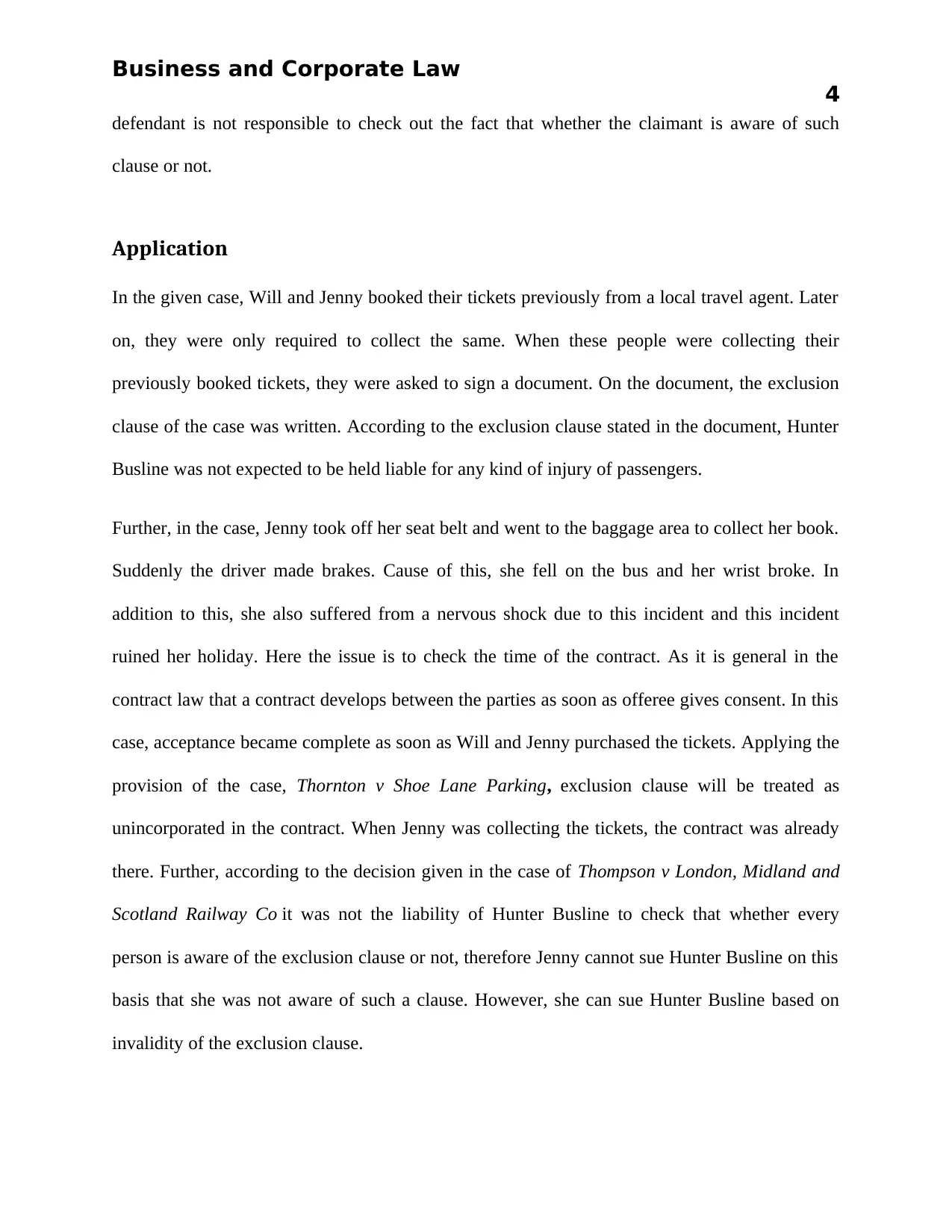
Business and Corporate Law
4
defendant is not responsible to check out the fact that whether the claimant is aware of such
clause or not.
Application
In the given case, Will and Jenny booked their tickets previously from a local travel agent. Later
on, they were only required to collect the same. When these people were collecting their
previously booked tickets, they were asked to sign a document. On the document, the exclusion
clause of the case was written. According to the exclusion clause stated in the document, Hunter
Busline was not expected to be held liable for any kind of injury of passengers.
Further, in the case, Jenny took off her seat belt and went to the baggage area to collect her book.
Suddenly the driver made brakes. Cause of this, she fell on the bus and her wrist broke. In
addition to this, she also suffered from a nervous shock due to this incident and this incident
ruined her holiday. Here the issue is to check the time of the contract. As it is general in the
contract law that a contract develops between the parties as soon as offeree gives consent. In this
case, acceptance became complete as soon as Will and Jenny purchased the tickets. Applying the
provision of the case, Thornton v Shoe Lane Parking, exclusion clause will be treated as
unincorporated in the contract. When Jenny was collecting the tickets, the contract was already
there. Further, according to the decision given in the case of Thompson v London, Midland and
Scotland Railway Co it was not the liability of Hunter Busline to check that whether every
person is aware of the exclusion clause or not, therefore Jenny cannot sue Hunter Busline on this
basis that she was not aware of such a clause. However, she can sue Hunter Busline based on
invalidity of the exclusion clause.
4
defendant is not responsible to check out the fact that whether the claimant is aware of such
clause or not.
Application
In the given case, Will and Jenny booked their tickets previously from a local travel agent. Later
on, they were only required to collect the same. When these people were collecting their
previously booked tickets, they were asked to sign a document. On the document, the exclusion
clause of the case was written. According to the exclusion clause stated in the document, Hunter
Busline was not expected to be held liable for any kind of injury of passengers.
Further, in the case, Jenny took off her seat belt and went to the baggage area to collect her book.
Suddenly the driver made brakes. Cause of this, she fell on the bus and her wrist broke. In
addition to this, she also suffered from a nervous shock due to this incident and this incident
ruined her holiday. Here the issue is to check the time of the contract. As it is general in the
contract law that a contract develops between the parties as soon as offeree gives consent. In this
case, acceptance became complete as soon as Will and Jenny purchased the tickets. Applying the
provision of the case, Thornton v Shoe Lane Parking, exclusion clause will be treated as
unincorporated in the contract. When Jenny was collecting the tickets, the contract was already
there. Further, according to the decision given in the case of Thompson v London, Midland and
Scotland Railway Co it was not the liability of Hunter Busline to check that whether every
person is aware of the exclusion clause or not, therefore Jenny cannot sue Hunter Busline on this
basis that she was not aware of such a clause. However, she can sue Hunter Busline based on
invalidity of the exclusion clause.
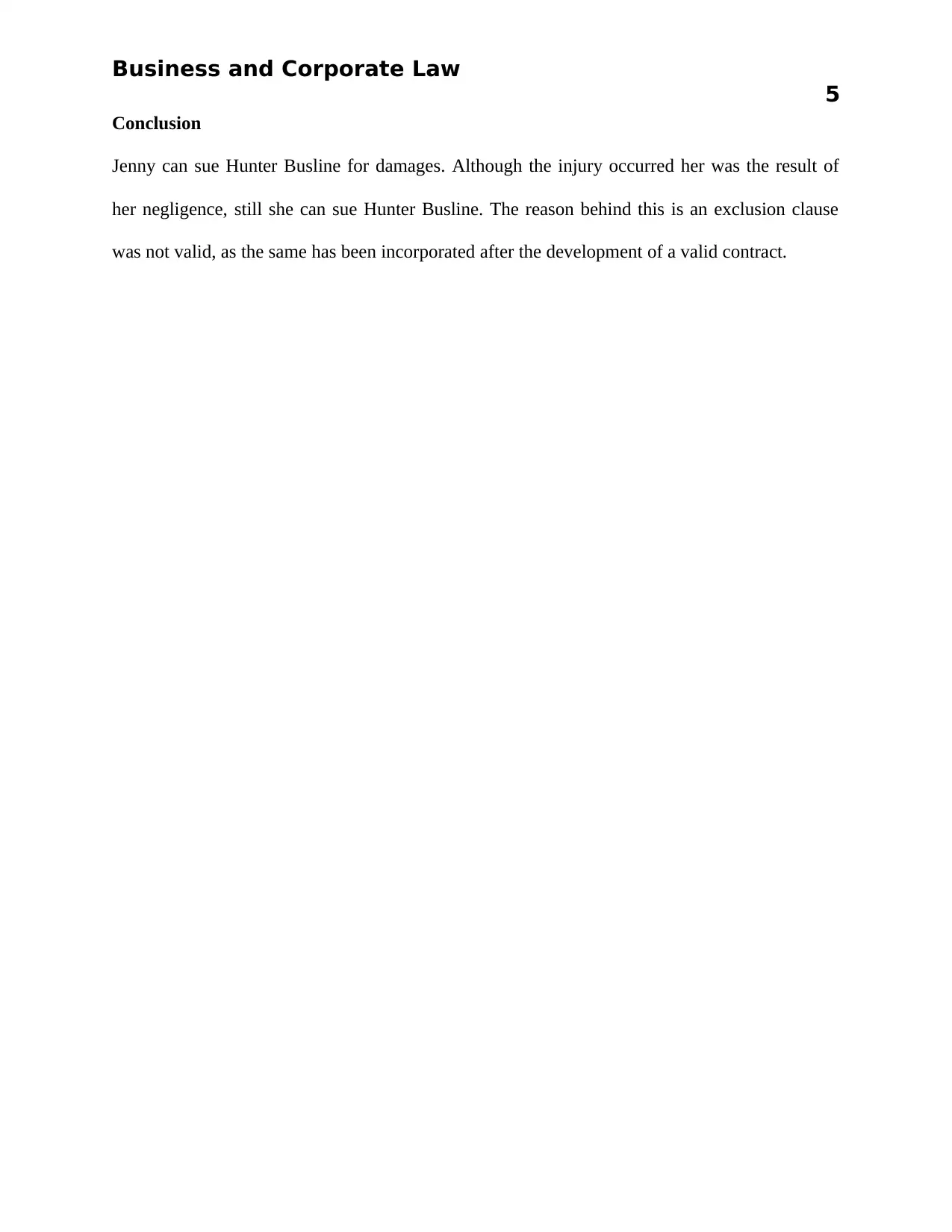
Business and Corporate Law
5
Conclusion
Jenny can sue Hunter Busline for damages. Although the injury occurred her was the result of
her negligence, still she can sue Hunter Busline. The reason behind this is an exclusion clause
was not valid, as the same has been incorporated after the development of a valid contract.
5
Conclusion
Jenny can sue Hunter Busline for damages. Although the injury occurred her was the result of
her negligence, still she can sue Hunter Busline. The reason behind this is an exclusion clause
was not valid, as the same has been incorporated after the development of a valid contract.
⊘ This is a preview!⊘
Do you want full access?
Subscribe today to unlock all pages.

Trusted by 1+ million students worldwide
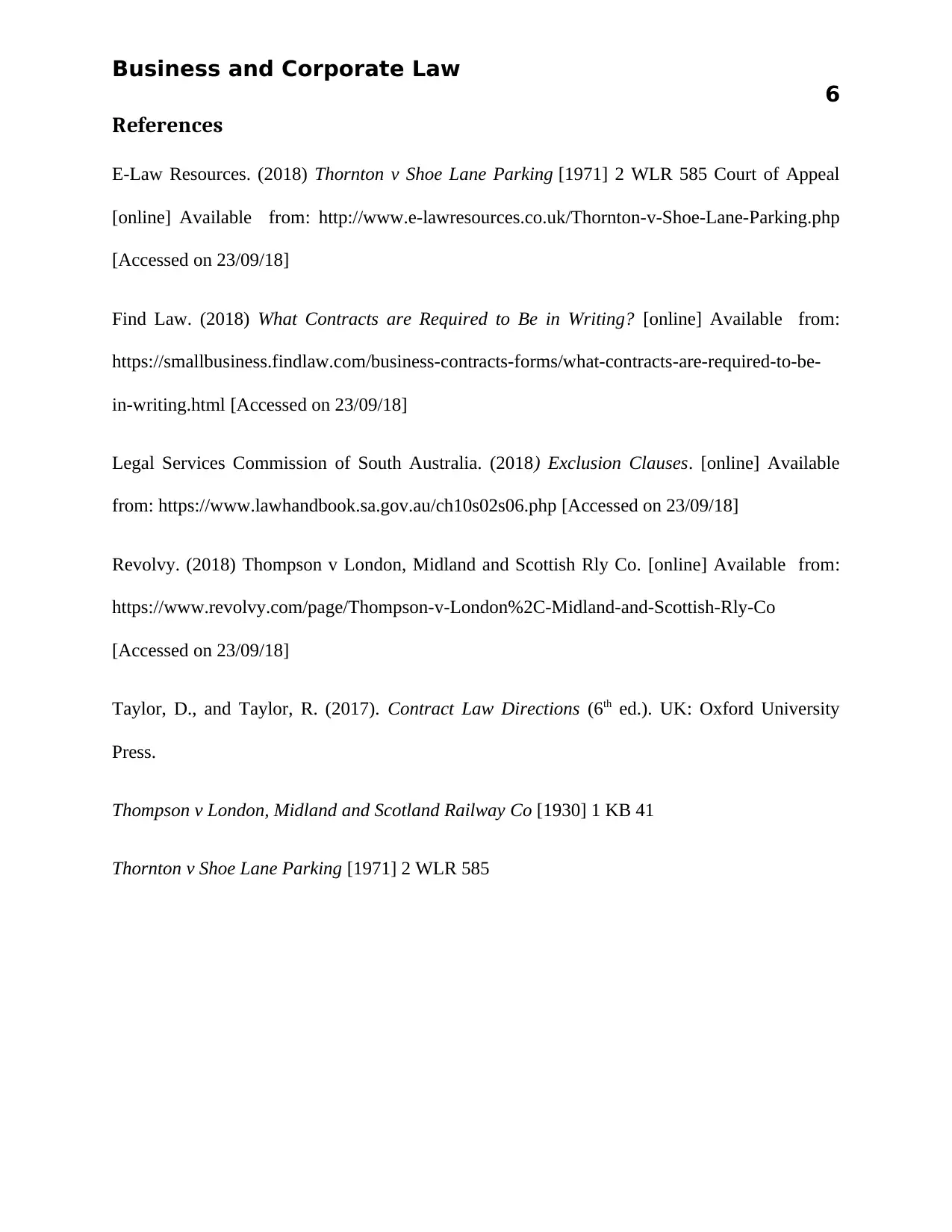
Business and Corporate Law
6
References
E-Law Resources. (2018) Thornton v Shoe Lane Parking [1971] 2 WLR 585 Court of Appeal
[online] Available from: http://www.e-lawresources.co.uk/Thornton-v-Shoe-Lane-Parking.php
[Accessed on 23/09/18]
Find Law. (2018) What Contracts are Required to Be in Writing? [online] Available from:
https://smallbusiness.findlaw.com/business-contracts-forms/what-contracts-are-required-to-be-
in-writing.html [Accessed on 23/09/18]
Legal Services Commission of South Australia. (2018) Exclusion Clauses. [online] Available
from: https://www.lawhandbook.sa.gov.au/ch10s02s06.php [Accessed on 23/09/18]
Revolvy. (2018) Thompson v London, Midland and Scottish Rly Co. [online] Available from:
https://www.revolvy.com/page/Thompson-v-London%2C-Midland-and-Scottish-Rly-Co
[Accessed on 23/09/18]
Taylor, D., and Taylor, R. (2017). Contract Law Directions (6th ed.). UK: Oxford University
Press.
Thompson v London, Midland and Scotland Railway Co [1930] 1 KB 41
Thornton v Shoe Lane Parking [1971] 2 WLR 585
6
References
E-Law Resources. (2018) Thornton v Shoe Lane Parking [1971] 2 WLR 585 Court of Appeal
[online] Available from: http://www.e-lawresources.co.uk/Thornton-v-Shoe-Lane-Parking.php
[Accessed on 23/09/18]
Find Law. (2018) What Contracts are Required to Be in Writing? [online] Available from:
https://smallbusiness.findlaw.com/business-contracts-forms/what-contracts-are-required-to-be-
in-writing.html [Accessed on 23/09/18]
Legal Services Commission of South Australia. (2018) Exclusion Clauses. [online] Available
from: https://www.lawhandbook.sa.gov.au/ch10s02s06.php [Accessed on 23/09/18]
Revolvy. (2018) Thompson v London, Midland and Scottish Rly Co. [online] Available from:
https://www.revolvy.com/page/Thompson-v-London%2C-Midland-and-Scottish-Rly-Co
[Accessed on 23/09/18]
Taylor, D., and Taylor, R. (2017). Contract Law Directions (6th ed.). UK: Oxford University
Press.
Thompson v London, Midland and Scotland Railway Co [1930] 1 KB 41
Thornton v Shoe Lane Parking [1971] 2 WLR 585
1 out of 7
Related Documents
Your All-in-One AI-Powered Toolkit for Academic Success.
+13062052269
info@desklib.com
Available 24*7 on WhatsApp / Email
![[object Object]](/_next/static/media/star-bottom.7253800d.svg)
Unlock your academic potential
Copyright © 2020–2025 A2Z Services. All Rights Reserved. Developed and managed by ZUCOL.





